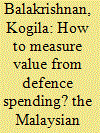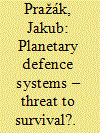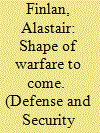|
|
|
Sort Order |
|
|
|
Items / Page
|
|
|
|
|
|
|
| Srl | Item |
| 1 |
ID:
181873


|
|
|
|
|
| Summary/Abstract |
Nations and their citizens now demand clear evidence as to the benefits of defence spending. The opportunity cost of defence expenditure against other sectors is constantly queried. It is economically challenging to find consensus amongst traditional economists, and policy-makers, on how to measure value in the context of defence. This article offers solutions by using the case study of Malaysia. Primary data sources include open-ended and semi structured interviews to produce a thematic discussion, as well as secondary resources. The author argues that it is hard to appraise defence value, as measurements are case-specific. Rather, the paper will use a novel ‘Triple-Defence Value Framework’, to argue that value can be measured by dividing the role of defence into a primary level: for protection and safety; a secondary level: for socio-economic prosperity; and a tertiary level: for soft power projection. The paper concludes by using the framework to measure the value derived from the Malaysian defence sector.
|
|
|
|
|
|
|
|
|
|
|
|
|
|
|
|
| 2 |
ID:
181876


|
|
|
|
|
| Summary/Abstract |
Russia seeks to convert the Black Sea into a Russian lake. This entails projecting power well into the Mediterranean Sea. Since 2013 Moscow has reinforced the missile, air defence, and submarine component of its Mediterranean Eskadra (Squadron) to deny NATO access to the Eastern Mediterranean and Black Seas. This article explains how and why Russia's Mediterranean Eskadra has become a major arm of Russia's military-political strategy in these waters. By analysing its missions, roles, and activities the article shows how Moscow conducts innovative, sophisticated, yet simultaneously traditional military-political operations to maximise and enhance its global standing in accordance with its own strategy. The article further argues that the Eskadra's creation and deployment corresponds not just to the revival of Russian military capability in 2013, but also to a much broader Russian perspective on contemporary war, and analyzes Russia's political considerations in the deployment of major military forces in the Mediterranean Basin.
|
|
|
|
|
|
|
|
|
|
|
|
|
|
|
|
| 3 |
ID:
181874


|
|
|
|
|
| Summary/Abstract |
The Philippine Navy is among the weakest of the naval forces in the Southeast Asia region, and its power projection capabilities are very limited. It is surprising how the Philippines, an archipelago country involved in maritime territorial disputes, could ignore the development of its maritime forces. As a result, the position of the Philippines in regional territorial disputes is weak. This study analyses the factors which have led to this situation, the PN modernisation process, and Filipino maritime power projection capabilities. The text is divided into three parts. The first defines the term “power projection” (or “force projection”). The second analyses the Philippines’ security challenges. Later, the potential and modernisation of the Philippine Navy, as well as its maritime power projection prospects, is analysed. The study concludes with findings. This study employs descriptive methodology and uses data from readily accessible sources to assess critically the conditions of this naval force.
|
|
|
|
|
|
|
|
|
|
|
|
|
|
|
|
| 4 |
ID:
181878


|
|
|
|
|
| Summary/Abstract |
The article explains why Weaponisation of outer space may soon be inevitable and that development of space weapons is a serious issue, especially in regard to dealing with sensitive dual-use technology. At the same time, the Earth may be threatened by incoming asteroids and comets, which may endanger humankind’s existence. Hence, it is advisable to develop effective planetary defence systems. However, the article claims that discussed planetary defence technology – kinetic impactor, nuclear explosion, gravity tractor and space tug, laser, and solar collector – have far-reaching dual-use consequences with potential for their weaponisation. Thus, the article argues in favour of greater transparency and surveillance mechanisms for dual-use and arms control. Moreover, the private sector should be involved in discussion since it may be contributing to negotiation processes and can ensure secure research and development, as well as operability of sensitive planetary defence systems.
|
|
|
|
|
|
|
|
|
|
|
|
|
|
|
|
| 5 |
ID:
181875


|
|
|
|
|
| Summary/Abstract |
Military hardware and technology transfer is increasingly becoming a crucial factor in international relations. This is especially so when the military hardware transfer involves sophisticated weapon's platforms that need specialised training and maintenance, resulting in a long-term relationship that strengthens the geopolitical relationship between the contracting parties. Driven by the re-emergence of great power rivalry, the S-400 Triumph air defence missile system deployment appears to be fast becoming a core component of Russia's military diplomacy. The agreed S-400 export contracts include Turkey, China and India with a long list of interested Middle Eastern countries. The transfer of S-400 well encompasses all the dimensions of the Russian defense diplomacy and could be considered as a primary example of scalable soft power, as it underlines the evolving pattern of high-technology arms transfers that is going to be constant in an increasingly complex multilateral world.
|
|
|
|
|
|
|
|
|
|
|
|
|
|
|
|
| 6 |
ID:
181877


|
|
|
|
|
| Summary/Abstract |
This research explores the shape of warfare to come over the next twenty-five years from a Swedish perspective. It is evident that change in the practice of warfare is apparent in international relations today due to the use of innovative new technologies. These developments raise profound practical and conceptual questions for armed forces as to what do these new systems mean for the prosecution of warfare and the intellectual ideas/knowledge base that underpin the contemporary application of force. This research offers a tentative exploration of three aspects (artificial intelligence, autonomous platforms and the future battlefield: the soldier level) framed in the context of the traditional environments of air, land and sea to interrogate their meaning for Sweden and future warfare.
|
|
|
|
|
|
|
|
|
|
|
|
|
|
|
|
|
|
|
|
|